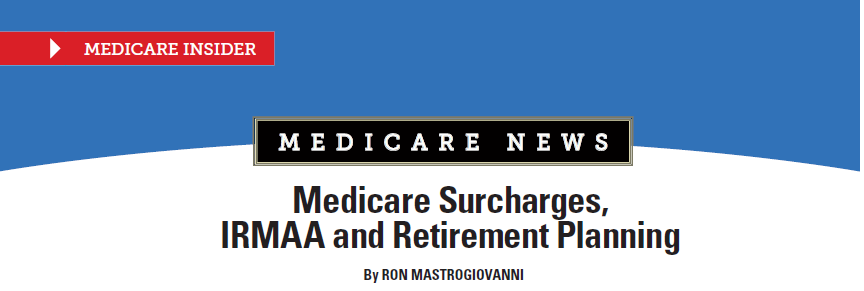
Over the last decade ensuring healthcare needs will be met in retirement has become one of the top priorities for clients of financial professionals.
This reflects growing awareness that health-related costs – Medicare, dental, and supplemental insurance premiums and out-of-pocket costs – will be among the most significant expenses impacting retirement budgets.
Our data shows that a healthy 65-year-old couple retiring this year and living to actuarially projected longevity will need to cover a projected $419,262 (future value) for lifetime Medicare, supplemental and dental premiums. When out-of-pocket costs are included, their total lifetime healthcare costs rise to $606,337.
Lifetime costs are one way to look at these expenses. Another is to look at them on an annual basis. Driven by a projected inflation rate of 4.9%, annual costs experienced between age 65 and age 85 will more than triple.
Younger Americans will feel the extra burden of compounding healthcare inflation. For a healthy 45-year-old couple retiring in 20 years, annual costs are notably higher: over $1.1 million in premiums and over $1.5 million in total lifetime healthcare costs when all out-of-pocket costs are added in (future value).
However we look at healthcare, it is a significant retirement expense. And, these projected costs do not reflect Medicare surcharges — our focus here.
History of IRMAA Surcharges
In 2003, President George W. Bush signed into law the Medicare Prescription Drug, Improvement, and Modernization Act. This established both Medicare Part D (an optional entitlement program for prescription drug coverage in retirement) and health savings accounts (HSAs). It also replaced Medicare + Choice with Medicare Advantage under Part C.
The Act introduced means testing of Medicare premiums with the introduction of IRMAA-based (income-related monthly adjusted amount) income brackets. The goal was for higher earning Medicare recipients to pay surcharges to increase Medicare revenue and extend the program’s solvency.
It’s important to note that Medicare Part B surcharges are deducted directly from Social Security benefits and surcharges are added to the cost of Part D premiums.
In 2007, five IRMAA income brackets went into effect based on marital status and annual modified adjusted gross income (MAGI). In the Medicare Access and CHIP Reauthorization Act of 2015, brackets 3, 4, and 5 were lowered, and bracket 6 was added.
Medicare Surcharges & Financial Professional Clients
For clients working with financial professionals and advisors, at least 50% of healthcare cost projection illustrations conducted using our planning tools find clients will be subject to Medicare surcharges. Since advised clients tend to have higher income than the average population, most will be subject to surcharges at some point in retirement.
As the table below shows, surcharges incurred at each of the six IRMAA income brackets will increase Medicare Parts B and D premiums from 35% to 214%.
| IRMAA 2020 Brackets Table | |||
| MAGI (Single) | MAGI (Married) | % Surcharge | |
| Bracket 1 | <$87,000 | <$174,000 | 0% |
| Bracket 2 | $87,001-$109,000 | $174,001-$218,000 | 35% |
| Bracket 3 | $109,001-$136,000 | $218,001-$272,000 | 89% |
| Bracket 4 | $135,001-$163,000 | $272,001-$326,000 | 143% |
| Bracket 5 | $163,000-$500,000 | $326,000-$750,000 | 196% |
| Bracket 6 | $500,001+ | $750,000+ | 214% |
Impact of the Indexing of Surcharges
Starting in 2020, IRMAA brackets are being indexed for the first time in a decade to the consumer price inflation index for all urban consumers (CPI-U). In November of last year, the Center for Medicare & Medicaid Services (CMS) announced an increase in IRMAA brackets by 1.9% over 2019 numbers. The expectation going forward is for brackets to adjust at an annual projected rate of 2.4% in the near future and approach 3.2% over the long term.
Overall, this means fewer retirees will be subject to surcharges than would have been the case if IRMAA brackets were not indexed. What it does not mean is that retirees no longer have to worry about surcharges. For many, annual retirement income growth will likely outstrip the rate of increase of these brackets. This will continue to mean retirees will find themselves in higher income brackets and paying more for Medicare.
It is also important to look at this in the broader context of Medicare solvency. Since the new policy will reduce revenue to the Medicare Trust Fund, there is no guarantee that indexing will not be suspended again, or that the income brackets will not be lowered at some point. (Both have happened in the past.) To compensate for potential revenue shortfalls, Medicare coverage is likely to be reduced, out-of-pocket costs will be higher, and premiums will increase.
As a case in point, in last year’s announcement of new IRMAA brackets for 2020, it was announced that Part B premiums will rise by 7%, more than three times the current CPI-U inflation rate.
The bottom line here is indexing has not changed the healthcare equation or the need to help clients plan for surcharges.
Financial Impact of Surcharges
In the first year of retirement, assuming our 65-year-old couple’s MAGI is $175,000, a 36% increase in premiums may not seem like a lot on the $4,479 they will pay for Medicare Parts B and D. But, assuming their retirement plans generate sufficient retirement income to at least keep pace with inflation, by age 85 their income will cross the MAGI thresholds for the 3rd bracket, resulting in significantly higher surcharges at a time when, driven by Medicare inflation, the cost of coverage will have grown considerably.
While the IRMAA brackets may seem high for many middle-class Americans, increasing numbers will be subject to them.
A 45-year-old woman making $77,000 this year who plans to retire in 20 years, may not expect surcharges will be an issue. But, if her income grows consistent with the Average Wage Index of 4% per year, and if IRMAA brackets are indexed at a projected CPI-U of 2.4%, when she turns 65 she will be subject to the 2nd income bracket and surcharges of 31%. If she remains in this bracket throughout retirement (from age 65 to 89), she will pay a total of $72,197 (future value) in surcharges for Medicare Parts B and D.
Product Selection to Reduce Surcharges
Financial professionals have an opportunity to work with clients on investment choices and the mix of products in a portfolio to help them plan for and even reduce surcharges.
Since all or some income from Roth IRAs, certain types of annuities and life insurance, reverse mortgages, and HSAs don’t count towards MAGI, incorporating them into financial plans offers a path to reducing the impact of surcharges. Since an extra $1 in income that qualifies toward MAGI may trigger thousands of dollars in additional Medicare premiums, it’s critical to review product mix with this in mind.
RMDs, Capital Gains & Loss of Spouse
Medicare surcharges may be impacted by a range of factors that need to be considered in the planning process.
Required minimum withdrawals can, for example, push a client’s MAGI across the first of existing IRMAA thresholds, triggering surcharges or increasing them.
Portions of the capital gains from the sale of a house or business, an inheritance or other capital gains which count toward MAGI can also lead to surcharges. Since they are calculated using a two-year look back on income, clients can find themselves facing lower benefits than they anticipated because they downsized their house or benefited from a capital gain in the two years before they retire. Few understand that they may have the ability to apply for exemptions for one-time events.
The death of a spouse will also have a significant impact on surcharges for the remaining partner, since the income level at which IRMAA brackets are crossed is halved. Even though the couple’s income may have been in the first bracket, and income for the surviving partner may be lower, the change in status from couple to individual may lead to surcharges being deducted from Social Security benefits. This can come as a shock.
Understand Medicare to Advise Clients
Helping clients understand the impact of healthcare costs and surcharges, and making planning decisions requires a basic understanding of Medicare along with resources to support client’s decision-making.
Our healthcare projection data, planning, and portfolio optimization tools, show clients their projected healthcare costs based on time to retirement, income, gender, State, and health condition. We also show the savings required at retirement to address them, and importantly, the impact of product selection on the surcharges they will have to pay in retirement.
Every client’s circumstances will be different, so it is important to go through this process on an individualized basis. Since healthcare is just one aspect of retirement planning, the impact of these expenses and surcharges need to be looked at in the context of an overall portfolio.
A couple who have saved $1 million with the goal of generating $50,000 a year in income, on top of Social Security benefits, may be surprised to find out how much of this will be needed just to cover their healthcare expenses in retirement.
For clients still planning for retirement, providing insight into future healthcare costs and surcharges offers a powerful incentive to increase retirement savings to ensure these expenses are addressed. Our experience working with some of the largest companies shows that clients increase retirement contributions and investments by as much as 25% when healthcare costs are shared.
In addition to driving increased retirement savings, conversations around healthcare and surcharges offer a path to adding additional value. Helping clients address one of their top priorities – their future healthcare needs – and saving them tens or perhaps hundreds of thousands on dollars in lifetime surcharges is a powerful way to grow assets, engage in product conversations and build stronger relationships.

Ron Mastrogiovanni is CEO of HealthView Services and HealthyCapital. HealthView Services (www.hvsfinancial.com) is the leading provider of retirement healthcare cost data, Social Security optimization, and long-term care retirement planning tools for the financial services industry. HealthyCapital (www.healthycapital.com) provides tools and savings data from condition management to incentivize improved health and retirement healthcare savings.
